Post-FEC Performance of Pilot-Aided Carrier Phase Estimation over Cycle Slip
Abstract
:1. Introduction
2. Experimental Setup and Principles
3. Experimental Results and Discussion
4. Conclusions
Author Contributions
Funding
Conflicts of Interest
References
- Savory, S.J. Digital Coherent Optical Receivers: Algorithms and Subsystems. IEEE J. Sel. Top. Quant. Electron. 2010, 16, 1164–1178. [Google Scholar] [CrossRef]
- Shieh, W.; Yang, Q.; Ma, Y. High-speed and high spectral efficiency coherent optical OFDM. In Proceedings of the Digest of the IEEE/LEOS Summer Topical Meetings, Acapulco, Mexico, 21–23 July 2008; pp. 115–116. [Google Scholar]
- Lau, A.P.T.; Lu, C. Beyond 100 Gb/s: Advanced DSP techniques enabling high spectral efficiency and flexible optical communications. In Proceedings of the International Conference on Optical Communications and Networks (ICOCN), Chengdu, China, 26–28 July 2013; pp. 1–5. [Google Scholar]
- Viterbi, A. Nonlinear estimation of PSK-modulated carrier phase with application to burst digital transmission. IEEE Trans. Inf. Theory 1983, 4, 543–551. [Google Scholar] [CrossRef]
- Zhou, X. DSP for high spectral efficiency 400G transmission. In Proceedings of the European Conference and Exhibition on Optical Communication (2013), London, UK, 22–26 September 2013; pp. 1–3. [Google Scholar]
- Gao, Y.; Lau, A.P.T.; Lu, C. Cycle-slip resilient carrier phase estimation for polarization multiplexed 16-QAM systems. In Proceedings of the Opto-Electronics and Communications Conference, Busan, Korea, 2–6 July 2012; pp. 154–155. [Google Scholar]
- Bisplinghoff, A.; Vogel, C.; Kupfer, T.; Langenbach, S.; Schmauss, B. Slip-reduced carrier phase estimation for coherent transmission in the presence of non-linear phase noise. In Proceedings of the Optical Fiber Communication Conference and Exposition and the National Fiber Optic Engineers Conference (OFC/NFOEC), Anaheim, CA, USA, 17–21 March 2013; pp. 1–3. [Google Scholar]
- Magarini, M.; Barletta, L.; Spalvieri, A.; Vacondio, F.; Pfau, T.; Pepe, M.; Bertolini, M.; Gavioli, G. Pilot-Symbols-Aided Carrier-Phase Recovery for 100-G PM-QPSK Digital Coherent Receivers. IEEE Photonics Technol. Lett. 2012, 9, 739–741. [Google Scholar] [CrossRef]
- Zhang, H.; Cai, Y.; Foursa, D.G.; Pilipetskii, A.N. Cycle slip mitigation in POLMUX-QPSK modulation. In Proceedings of the Optical Fiber Communication Conference and Exposition and the National Fiber Optic Engineers Conference, Los Angeles, CA, USA, 6–10 March 2011; pp. 1–3. [Google Scholar]
- Fludger, C.; Nuss, D.; Kupfer, T. Cycle-Slips in 100G DP-QPSK Transmission Systems. In Proceedings of the Optical Fiber Communication Conference (OFC), Los Angeles, CA, USA, 4–8 March 2012. [Google Scholar]
- Rozental, V.N.; Kong, D.; Foo, B.; Corcoran, B.; Lowery, A. Low Complexity Blind Phase Recovery Algorithm with Increased Robustness Against Cycle-Slips. In Proceedings of the European Conference and Exhibition on Optical Communications (ECOC), Gothenburg, Sweden, 17–21 September 2017; pp. 1–3. [Google Scholar]
- Rozental, V.N.; Kong, D.; Foo, B.; Corcoran, B.; Lowery, A. Cycle-slip-less low-complexity phase recovery algorithm for coherent optical receivers. Opt. Lett. 2017, 18, 3554–3557. [Google Scholar] [CrossRef] [PubMed]
- Kawase, H.; Mori, Y.; Hasegawa, H.; Sato, K. Cycle-slip-tolerant decision-boundary creation with machine learning. In Proceedings of the International Conference on Photonics (ICP), Kuching, Malaysia, 14–16 March 2016; pp. 1–3. [Google Scholar]
- Koike-Akino, T.; Yoshida, T.; Parsons, K.; Millar, D.S.; Kojima, K.; Pajovic, M. Fully-parallel soft-decision cycle slip recovery. In Proceedings of the Optical Fiber Communications Conference and Exhibition (OFC), Los Angeles, CA, USA, 19–23 March 2017. [Google Scholar]
- Yu, F.; Stojanovic, N.; Hauske, F.N.; Chang, D.; Xiao, Z.; Bauch, G.; Pflueger, D.; Xie, C.; Zhao, Y.; Jin, L.; et al. Soft-decision LDPC turbo decoding for DQPSK modulation in coherent optical receivers. In Proceedings of the European Conference and Exhibition on Optical Communication (ECOC), Geneva, Switzerland, 18–22 September 2011. [Google Scholar]
- Bisplinghoff, A.; Langenbach, S.; Kupfer, T.; Schmauss, B. Turbo Differential Decoding Failure for a Coherent Phase Slip Channel. In Proceedings of the European Conference and Exhibition on Optical Communication (ECOC), Amsterdam, The Netherlands, 16–20 September 2012. [Google Scholar]
- Bisplinghoff, A.; Langenbach, S.; Beck, N.; Fludger, C.R.S.; Kupfer, T.; Schulien, C. Cycle slip tolerant hybrid turbo differential decoding. In Proceedings of the European Conference on Optical Communication (ECOC), Cannes, France, 21–25 September 2014; pp. 1–3. [Google Scholar]
- Koike-Akino, T.; Kojima, K.; Millar, D.S.; Parsons, K.; Miyata, Y.; Matsumoto, W.; Sugihara, T.; Mizuochi, T. Cycle slip-mitigating turbo demodulation in LDPC-coded coherent optical communications. In Proceedings of the Optical Fiber Communications Conference and Exhibition (ECOC), San Francisco, CA, USA, 9–13 March 2014. [Google Scholar]
- Leong, M.Y.; Larsen, K.J.; Jacobsen, G.; Popov, S.; Zibar, D.; Sergeyev, S. Novel BCH code design for mitigation of phase noise induced cycle slips in DQPSK systems. In Proceedings of the Lasers and Electro-Optics (CLEO), San Jose, CA, USA, 8–13 June 2014. [Google Scholar]
- Schmalen, L. A Low-Complexity LDPC Coding Scheme for Channels with Phase Slips. J. Light. Technol. 2015, 7, 1319–1325. [Google Scholar] [CrossRef]
- Schmalen, L. Low-complexity phase slip tolerant LDPC-based FEC scheme. In Proceedings of the European Conference on Optical Communication (ECOC), Cannes, France, 21–25 September 2014; pp. 1–3. [Google Scholar]
- Cao, S.; Kam, P.Y.; Yu, C.; Cheng, X. Pilot-Tone Assisted Log-Likelihood Ratio for LDPC Coded CO-OFDM System. IEEE Photonics Technol. Lett. 2014, 15, 1577–1580. [Google Scholar] [CrossRef]
- Koikeakino, T.; Millar, D.S.; Kojima, K.; Parsons, K. Phase Noise-Robust LLR Calculation with Linear/Bilinear Transform for LDPC-Coded Coherent Communications. In Proceedings of the Lasers and Electro-Optics (CLEO), San Jose, CA, USA, 10–15 May 2015. [Google Scholar]
- Cheng, H.; Li, Y.; Zhang, F.; Wu, J.; Lu, J.; Zhang, G.; Xu, J.; Lin, J. Experimental Demonstration of Pilot-Symbols-Aided Cycle Slip Mitigation for QPSK Modulation Format. Opt. Express 2013, 19, 22166–22172. [Google Scholar] [CrossRef] [PubMed]
- Lu, J.; Fu, S.; Hu, Z.; Deng, L.; Tang, M.; Liu, D.; Chan, C.C.K. Carrier Phase Recovery for Set-Partitioning QAM Formats. J. Light. Technol. 2018, 18, 4129–4137. [Google Scholar] [CrossRef]
- DVB-S.2 Standard Specification, ETSI EN 302 307 V1.3.1. Available online: http://www.etsi.org/deliver/etsi_en/302300_302399/302307/01.03.01_60/en_302307v010301p.pdf (accessed on 1 March 2013).
- Cheng, H.; Li, Y.; Kong, D.; Zang, J.; Wu, J.; Lin, J. Low overhead slipless carrier phase estimation scheme. Opt. Express 2014, 17, 20740–20747. [Google Scholar] [CrossRef] [PubMed]
- Chang, S.H.; Chung, H.S.; Kim, K. Impact of quadrature imbalance in optical coherent QPSK receiver. IEEE Photonics Technol. Lett. 2009, 11, 709–711. [Google Scholar] [CrossRef]
- Gardner, F. A BPSK/QPSK timing-error detector for sampled receivers. IEEE Trans. Commun. 1986, 5, 423–429. [Google Scholar] [CrossRef]
- Leven, A.; Kaneda, N.; Koc, U.V.; Chen, Y.K. Frequency estimation in intradyne reception. IEEE Photonics Technol. Lett. 2007, 6, 366–368. [Google Scholar] [CrossRef]
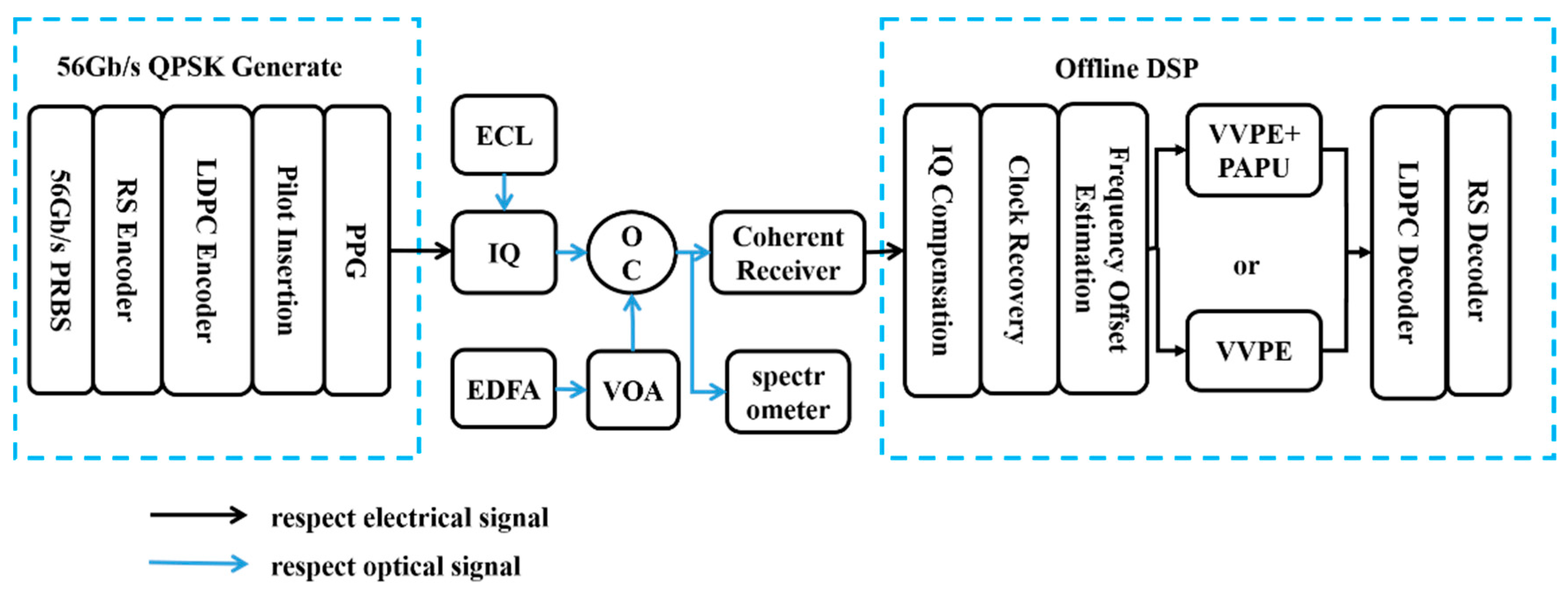

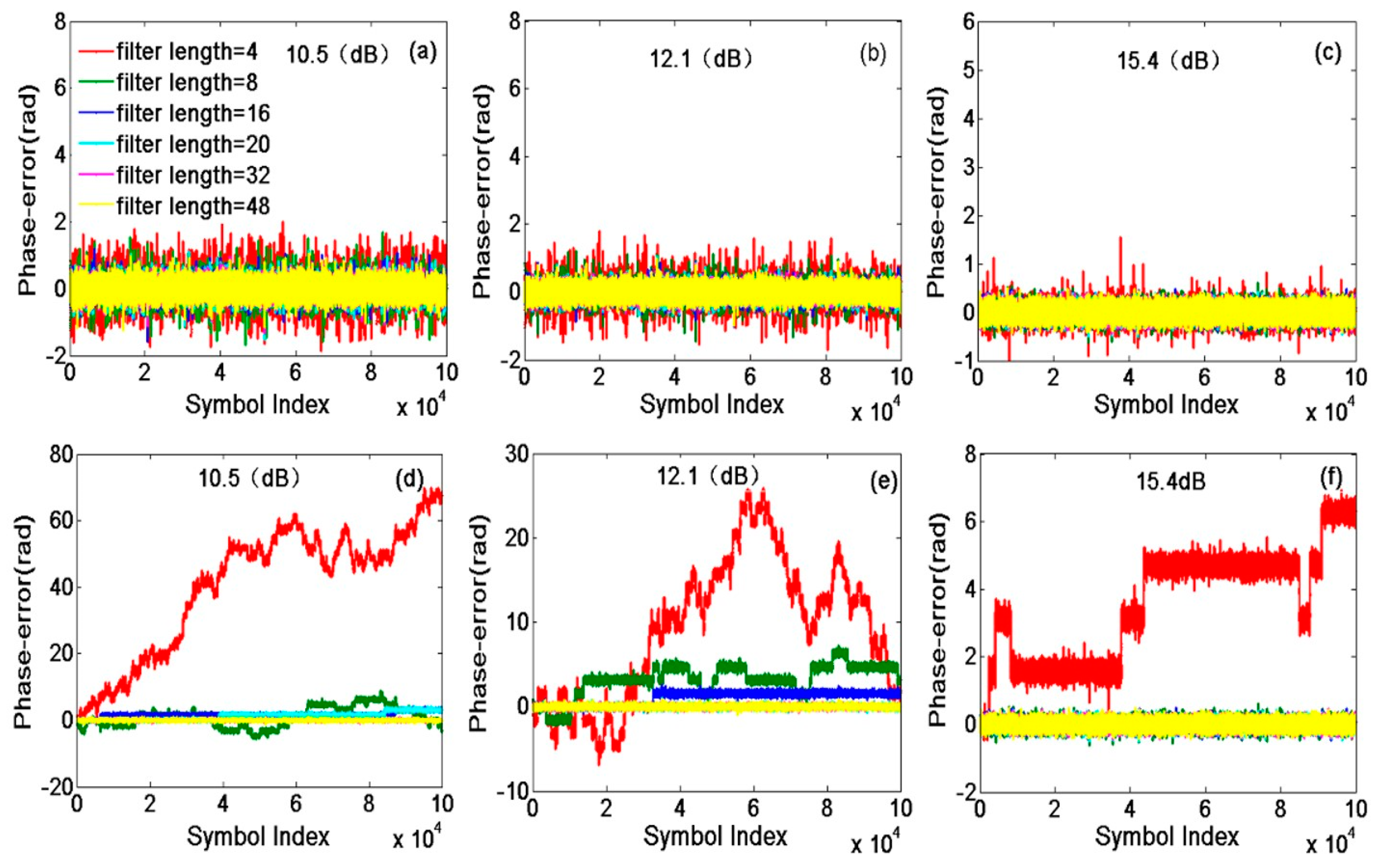
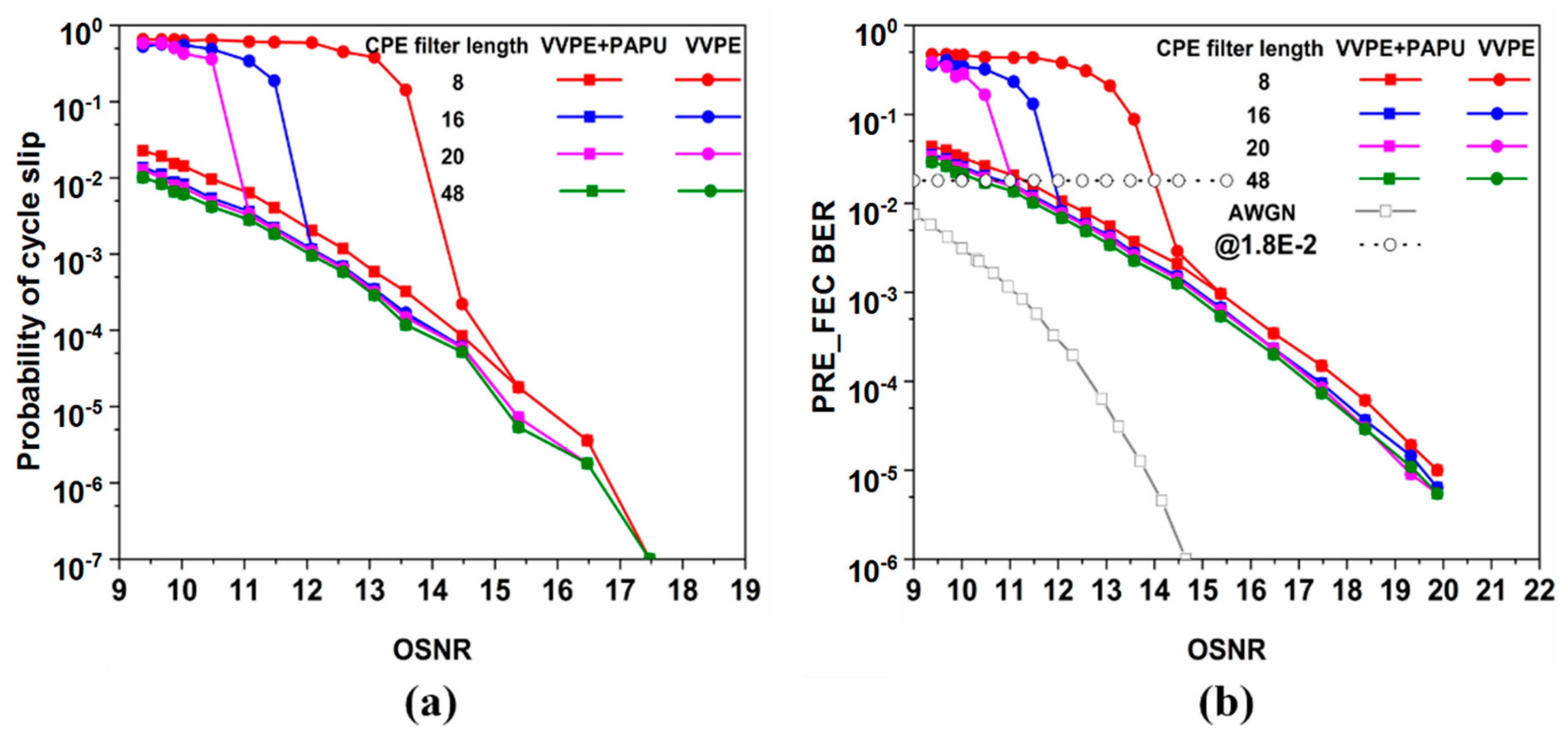
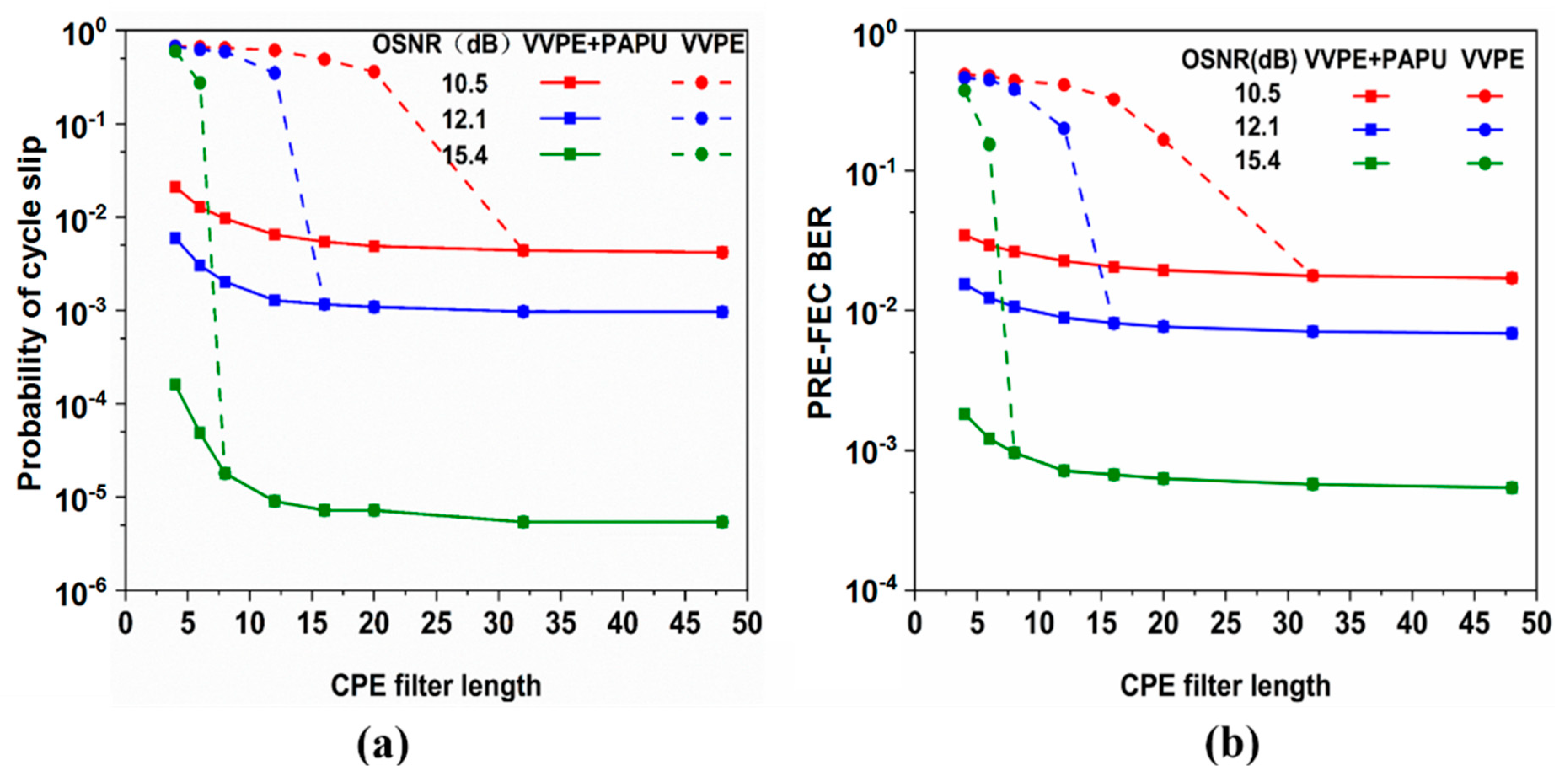
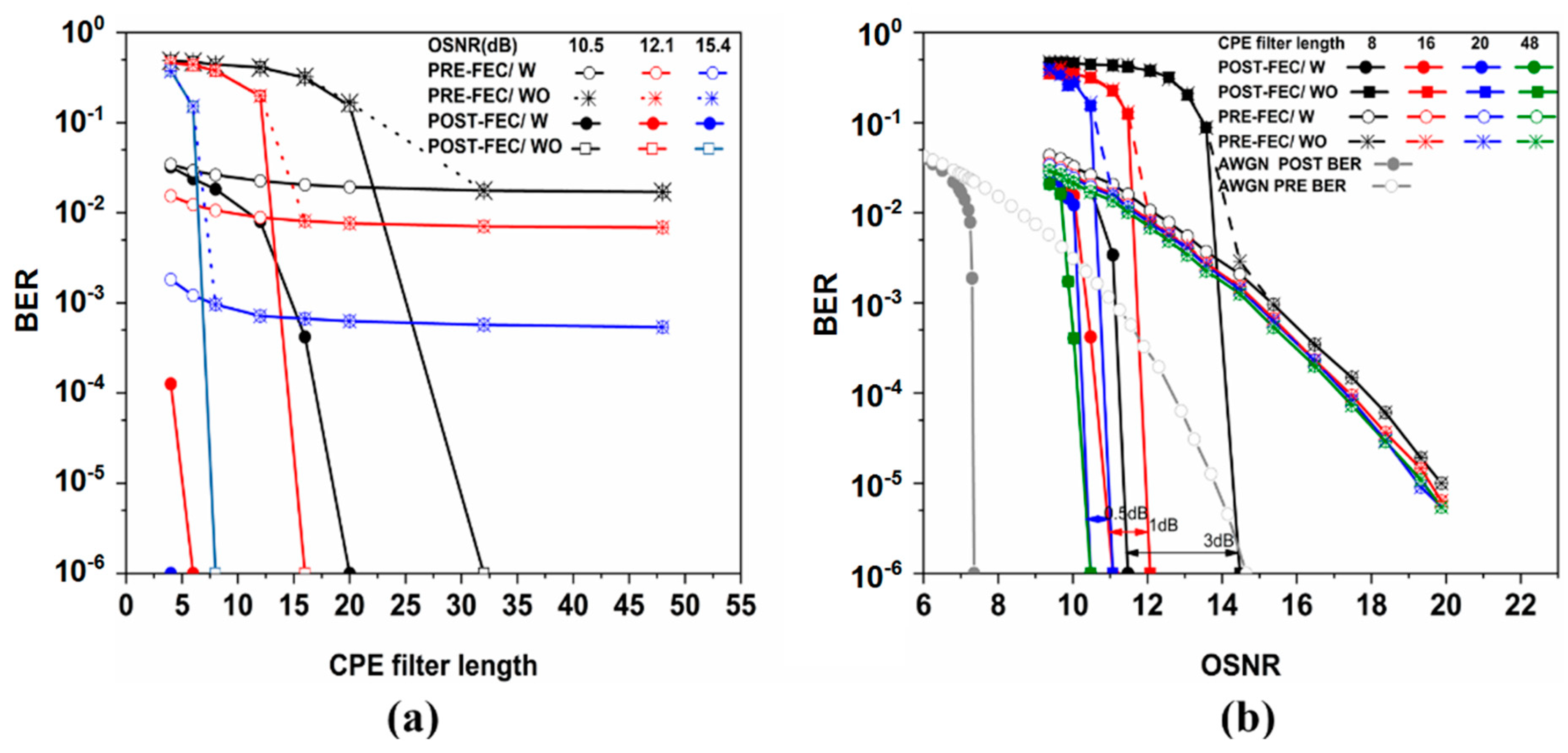
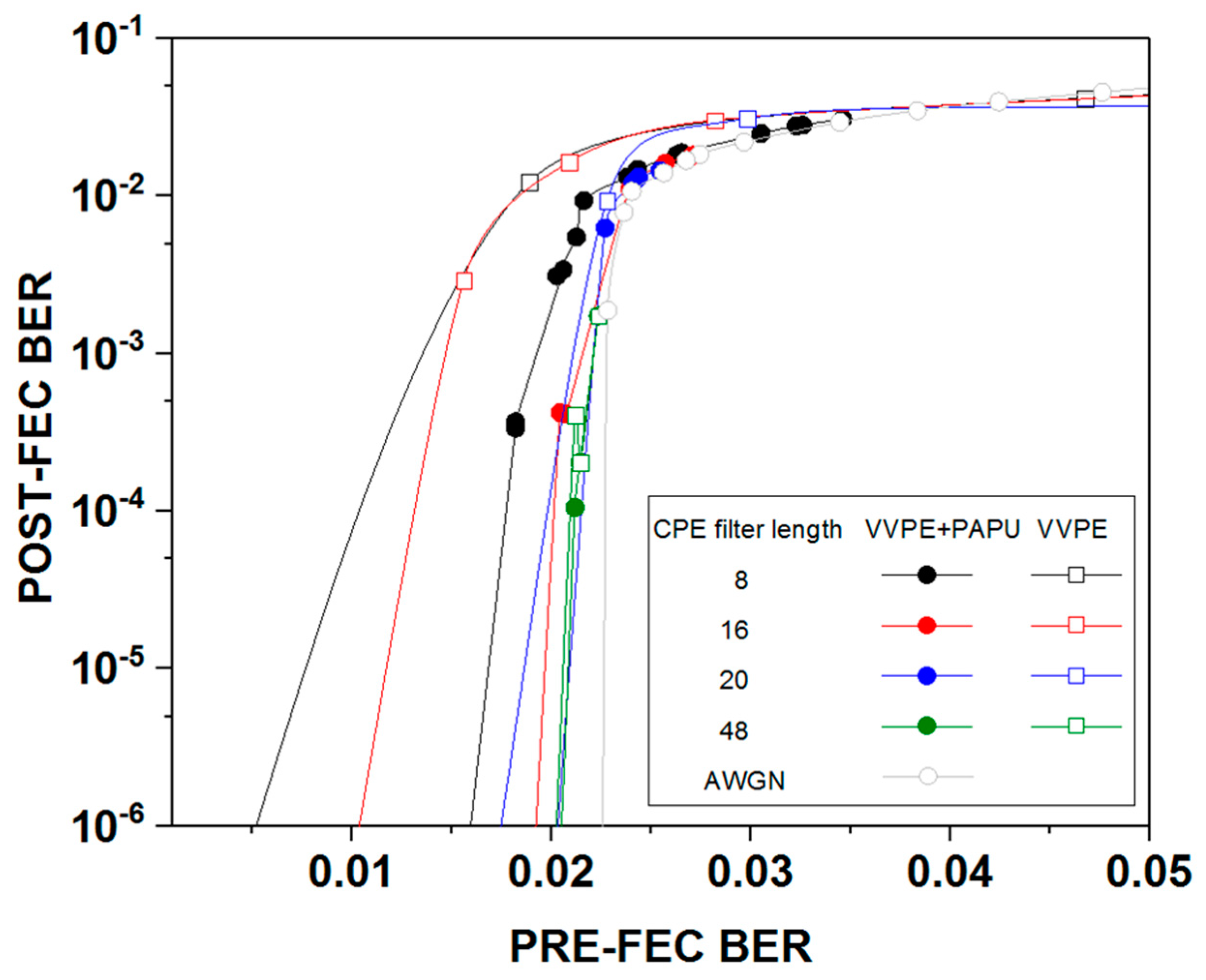
| Parameters | Values |
|---|---|
| Symbol Rate | 28-Gbaud |
| Wavelength | 1550-nm |
| Linewidth | 300-kHz |
| Bandwidth of Modulator | 40-GHz |
| Bandwidth of Receiver | 33-GHz |
| Sampling Rate | 80-GSa/s |
© 2019 by the authors. Licensee MDPI, Basel, Switzerland. This article is an open access article distributed under the terms and conditions of the Creative Commons Attribution (CC BY) license (http://creativecommons.org/licenses/by/4.0/).
Share and Cite
Li, Y.; Ning, Q.; Yue, L.; Zhou, H.; Gao, C.; Liu, Y.; Qiu, J.; Li, W.; Hong, X.; Wu, J. Post-FEC Performance of Pilot-Aided Carrier Phase Estimation over Cycle Slip. Appl. Sci. 2019, 9, 2749. https://doi.org/10.3390/app9132749
Li Y, Ning Q, Yue L, Zhou H, Gao C, Liu Y, Qiu J, Li W, Hong X, Wu J. Post-FEC Performance of Pilot-Aided Carrier Phase Estimation over Cycle Slip. Applied Sciences. 2019; 9(13):2749. https://doi.org/10.3390/app9132749
Chicago/Turabian StyleLi, Yan, Quanyan Ning, Lei Yue, Honghang Zhou, Chao Gao, Yuyang Liu, Jifang Qiu, Wei Li, Xiaobin Hong, and Jian Wu. 2019. "Post-FEC Performance of Pilot-Aided Carrier Phase Estimation over Cycle Slip" Applied Sciences 9, no. 13: 2749. https://doi.org/10.3390/app9132749
APA StyleLi, Y., Ning, Q., Yue, L., Zhou, H., Gao, C., Liu, Y., Qiu, J., Li, W., Hong, X., & Wu, J. (2019). Post-FEC Performance of Pilot-Aided Carrier Phase Estimation over Cycle Slip. Applied Sciences, 9(13), 2749. https://doi.org/10.3390/app9132749






